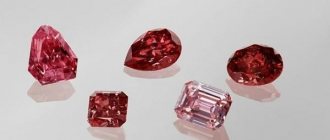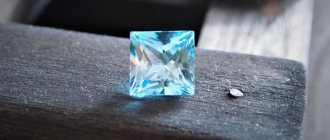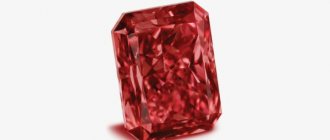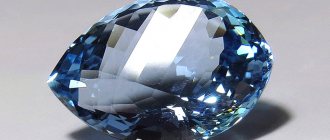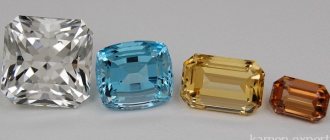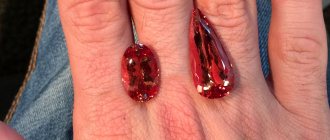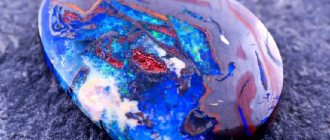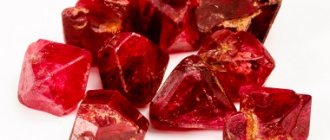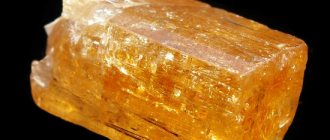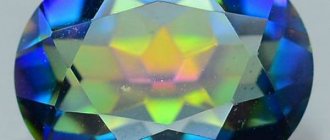Imperial topaz is also known as "precious". This is the most popular natural mineral of this variety. It is believed that it received its name from the Russian tsars of the 17th century. This is because the Tsars demanded exclusive rights to these pink-hued precious stones mined in Russia.
The mineral has a yellow, pink or pink-orange hue. The natural pink variety is very rare. Brazilian imperial topaz can range in color from bright yellow to deep golden brown and sometimes even purple.
Imperial topaz can be distinguished from other pink stones (such as kunzite, tourmaline, sapphire and ruby) by its hardness (8 on the Mohs scale). This species is less common than others, which makes it more valuable.
Gold bracelet with topazes and swarovski cubic zirconias (go to the SUNLIGHT catalogue)
Characteristics of the mineral
The unique gem was found by Brazilian miners in the 18th century. The stone instantly became popular and in demand by jewelers. Even jewelry connoisseurs were amazed by the new color of the well-known topaz. If previously specimens of cold and light tones were predominantly found, then everyone was simply delighted with this find.
Even today, experts do not have a clear agreement on which stone to call imperial. The real standard is considered to be a mineral that has a red-brown color. Such finds, which are as close in color as possible to this source, are also traditionally called imperial topazes. The stones can be peach or even cherry in color. Gemologists have developed their own criterion for authenticity - a real imperial topaz should resemble lightly salted salmon in color.
For quite a long period of time, it was customary to call specimens mined exclusively in Brazil “imperial topaz.” A little later, gems from Asia began to be supplied to the jewelry market. They were mined in Afghanistan and Pakistan. On the territory of Russia, similar images were discovered in the Ural mountains. Due to their rather large weight, the workers nicknamed these stones “heavy”. Even today, Brazilians continue to claim that only specimens mined in their country can be called genuine imperial topazes.
Story
For thousands of years, people found only blue, gold or smoky topazes. The Renaissance added pink. Their beauty was not immediately appreciated, only after learning how to cut them.
Pink and golden gems were fashionable in Russia, but their Ural reserves quickly dried up. There are cheap smoky and milky ones left. Even ordinary wealthy people could afford them. Chance and ingenuity helped. The wife of the Ural artisan Volokolamov dropped an earring with a yellowish stone into the dough.
The loss was discovered when the baked goods were cut. It was discovered that the gem had turned a magnificent pink. The husband thought of putting a batch of cheap grayish stones into the oven. At the end of the day, he received pink splendor, made the capital's fashionistas happy, and got rich along the way.
What is special about the imperial color?
Industrial mining of imperial topaz began in 1730. This happened in Brazil in the Oro Preto region. The main advantage of such minerals is their orange-brown color and subtle pink tint, which can be seen in the precious facets.
Gemologists argue a lot about which gems have the right to be called imperial. Some insist that only pink specimens with a golden hue can be presented under this brand. Others insist that yellow and purple stones must also be included here. Many sellers resort to such a trick, because the cost of a specimen near which there is a stock exchange with the indication “imperial” literally skyrockets compared to ordinary topazes.
Mythology, metaphysical and healing powers
Since ancient times, topazes have been considered healing stones. They brought well-being, helped with mental illness, depression, and reproductive problems; contributed to the disinfection of the body.
Indian doctors claim that the stone can tone the heart and purify the blood of patients. The Chinese are confident that imperial draws the energy of the sun and makes a person healthier. Therefore, topaz should be in almost every person’s home.
The ancient Greeks believed that the imperial was a powerful stone that could enhance the wearer's powers and even provide invisibility. While the ancient peoples of Egypt and Rome associated yellow topazes with the Sun God.
This is a stone for those born in November and those whose zodiac sign is Sagittarius. The 24th wedding anniversary is associated with the mineral. In the traditional Indian belief system, imperial is believed to have the ability to open the throat chakra, which facilitates communication and self-expression. Because of this, it is believed that the stone should be given to artists, writers, public speakers and other people who are engaged in self-expression. There is an opinion that this topaz promotes masculinity of the stronger half of humanity.
Gold earrings with topaz and cubic zirconia (go to the SUNLIGHT catalogue)
From pure clear to golden and sunny yellows and even a fiery pink-reddish hue, Imperial warms everything with its energy, dispersing and radiating its gentle power in all directions, soothing, stimulating and recharging. It brings solid, lasting energy, joy, generosity and abundance. Imperial Topaz takes its solar influence from across the sky, where strength and vitality become inspiration, breath and impulse. This promotes forgiveness, expression and confidence in pursuing one's aspirations.
Imperial is also considered a stone with lunar connections - its color and power are in alliance with the cycle of the Moon. The stone is considered as a "crystal of potency"; it has ends and edges that produce both positive and negative currents. A request to the Universe, focused on this mineral, allows you to intensely clarify intention and increase the concentration of thoughts, energy and actions to manifest your desires into physical reality. The stone is very effective for visualization, meditation and projection; is an excellent talisman for insightful wisdom.
What you need to know about a beautiful stone
Few people know that the demand for the precious stone significantly exceeds the supply. To earn more and fill the market with the desired product, many suppliers use tricks.
Most topaz that has no defects has a yellowish tint or is completely colorless. In laboratory conditions, a person can artificially change color through the process of heating or irradiation. After such experiments, the stone turns into a real imperial, and it is very difficult to distinguish its natural specimen.
Knowing this trick, collectors and experienced jewelers prefer to buy topazes with barely noticeable defects. Such natural “disadvantages” are typical for Brazilian deposits. This way, the buyer will be sure that he paid a high price for a natural gem, and not one refined in a laboratory.
Usage
Royal topaz is used primarily for making jewelry. Their range is very wide; in stores you can find everything from rings to brooches.
Imperial crystal typically costs up to $3,500 per carat. Pink topaz is the most expensive, and yellow topaz is the cheapest. The price depends on the frequency; the mineral of a certain shade is found in nature with the bark. In addition, uncut imperial crystals are often purchased by collectors. Many people prefer stones with defects characteristic of Brazilian deposits - this is a kind of evidence of authenticity.
In addition to the jewelry industry, topazes are used in steelmaking, the production of refractory materials, and metal grinding in the production of construction tools.
Imperial topaz amazes with its beauty, rarity and amazing play of color. The gem not only pleases with its appearance, but is also able to lift the owner up the career ladder and strengthen his financial position.
How many fake imperials are there?
There is a very small percentage of natural topazes on the jewelry market, which, after heat treatment or radiation exposure in a laboratory, turn into imperials.
In order for a colorless or yellowish stone to become pink, it must initially contain a small amount of chromium impurity. There are very few similar aluminosilicates found in nature. Even if such specimens circulate, many have significant defects, cracks and bubbles. This significantly reduces the final cost of even treated stones, and some do not even meet the required quality.
Chemical-containing topazes are used in imperial jewelry production. In the laboratory, they are subjected to heat treatment - this can be exposure for 45 minutes at a temperature of 450 degrees in an acid-free environment, or treatment at a temperature of 565 degrees for 40 minutes in the presence of an acidic environment. As a result, the topaz lightens and its red undertone begins to appear. The final color of such an “imperial” topaz depends on how intense the original color was. Using well-known technology in the laboratory, specialists have learned to produce imperials of different tones.
During the heat treatment process, topaz is additionally hardened. The wear resistance and strength of the refined gem is at the highest level. Such specimens, unlike natural ones, do not lose their color under prolonged exposure to sunlight and even after long-term storage they look excellent.
Origins
The commercially mined mineral originates from Brazil. There are deposits in the Urals (Russia). Pegmatite deposits are being developed in Pakistan and Afghanistan, and mining is underway on the island of Sri Lanka.
Imperial was originally classified as orange with red dichroism. Nowadays it is more widely available in yellow, pink, red and pink-peach shades. Sometimes the color may gradually fade over time when the stone is exposed to sunlight.
What is the name of the gem associated with?
Imperial topaz sounds proud and unusual, but few people know what this name is associated with. There is a widespread belief that the sellers themselves came up with the name, because it is sonorous and always attracted attention to the presented product.
If you look at it, the unique color of the mineral fully corresponds to its name. In the jewelry world, great importance is attached not only to the color of the stone, but also to its physical and chemical characteristics; in this regard, imperial has also achieved high levels:
- hardness – 9 points on the Mohs scale;
- color depends on the type of crystal lattice and the presence of impurities in the composition;
- metallic shine;
- molecular weight corresponds to diamond - 3.53.
It is difficult for a person who does not have special knowledge to distinguish a gem known throughout the world from a mineral refined in a laboratory, but both specimens are worthy of attention and the highest praise.
WHERE APPLICABLE
Mineral crystals are traditionally used as jewelry inserts. Rare examples of imperial topaz become pieces of private collections.
Magical and healing properties
Yellowish topaz, according to the beliefs of the ancient Egyptians and Romans, is a talisman of the solar deity, Ra and Jupiter. Hindus believed that topaz opens the chakras of the larynx, enhancing oratory and expressiveness. Therefore, it was recommended to be worn by artists and publicists.
According to legend, the imperial brought good luck to the owner and protected him from magical spells - both light and dark. The mystical properties were attributed to the ability of the crystal to change color if poisoned food or drink was nearby.
Depending on the phase of the moon, topaz was used to treat insomnia, asthma and hemorrhoids. We recommend: APATITE - the many-sided deceiving mineral
Compatibility with Zodiac signs
The amulet is suitable for signs born in November - Scorpios and Sagittarius.
Therapeutic properties
Looking at the photo of a luxurious imperial, you should remember that it has not only external attractiveness, but also powerful energy. The power of the stone should be used correctly and then it will have a beneficial effect on the body.
Topaz Imperial will help:
- improve vision, it helps with myopia and farsightedness;
- improve the cardiovascular system;
- in the treatment of pathologies of the endocrine system;
- alleviate the condition of epilepsy (for this it is better to wear silver jewelry with imperial);
- reduce the pain of gout attacks;
- relieve inflammation.
Constantly wearing jewelry with natural stone will gradually relieve insomnia, psychological problems, and reduce the level of anxiety.
Who is suitable according to their zodiac sign?
Reddish-pink stones can be used by almost all zodiac signs.
According to the horoscope, the gem is especially suitable for Pisces, Aquarius and Leo.
| Zodiac sign | Compatibility |
| Aries | + |
| Taurus | _ |
| Capricorn | + |
| Cancer | + |
| a lion | +++ |
| Virgo | + |
| Scales | + |
| Scorpion | + |
| Sagittarius | + |
| Capricorn | + |
| Aquarius | +++ |
| Fish | +++ |
(“+++” – fits perfectly, “+” – can be worn, “-” – is strictly contraindicated)
Magical abilities of the stone
Esotericists and psychics advise taking a closer look at the gem. He has powerful energy potential that must be used for his own benefit. All topazes are capable of calming a person’s anger, eliminating attacks of aggression, and imperial is no exception. The stone will give its owner the desired peace of mind and serenity. A person who buys a crystal for himself will approach everything in life with optimism. Topaz is also called the “stone of enlightenment”; it will help you deal with mental torment.
Imperial endows its owner with wisdom. Esotericists recommend wearing such jewelry for important negotiations. The power of a precious talisman will help you make the right decision and not give in to emotions. The gem will also help make a favorable impression on new partners with whom future cooperation is planned.
There is another area in which the power of the stone will actively help a person - this is money. Imperial will attract material wealth into life. Of course, this is possible if the person himself works to improve the quality of life.
Topaz will come in handy and help schoolchildren and students. Under its influence, intelligence and ability to work will increase, and new information will be easier to assimilate.


